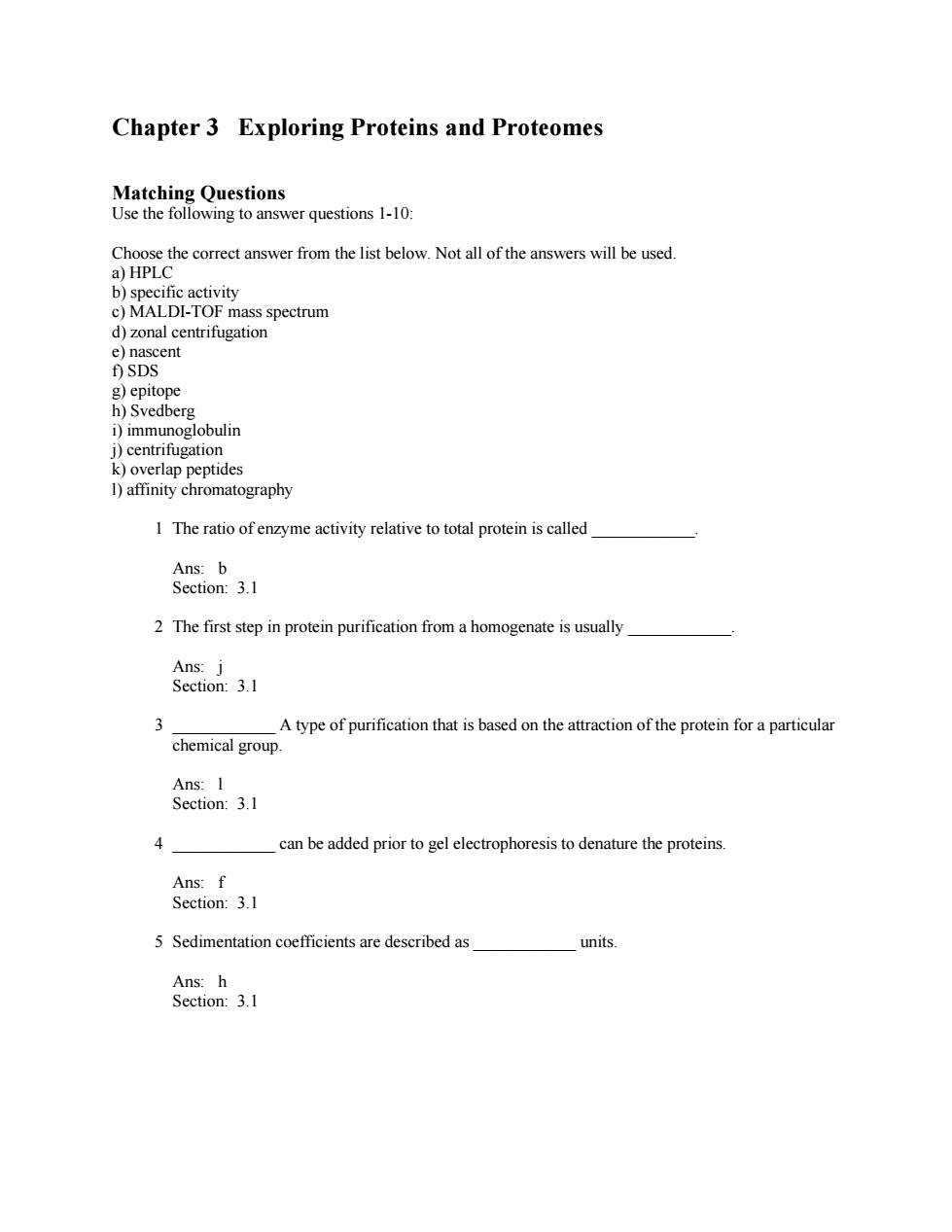
Chapter 3 Exploring Proteins and Proteomes Matching Questions Use the following to answer questions 1-10: Choose the correct answer from the list below.Not all of the answers will be used a)HPLC b)specific activity c)MALDI-TOF mass spectrum d)zonal centrifugation e)nascent f)SDS g)epitope h)Svedberg i)immunoglobulin j)centrifugation k)overlap peptides 1)affinity chromatography 1 The ratio of enzyme activity relative to total protein is called Ans:b Section:3.1 2 The first step in protein purification from a homogenate is usually Ans:j Section:3.1 A type of purification that is based on the attraction of the protein for a particular chemical group Ans:I Section:3.1 can be added prior to gel electrophoresis to denature the proteins. Ans:f Section:3.1 5 Sedimentation coefficients are described as units. Ans:h Section:3.1
Chapter 3 Exploring Proteins and Proteomes Matching Questions Use the following to answer questions 1-10: Choose the correct answer from the list below. Not all of the answers will be used. a) HPLC b) specific activity c) MALDI-TOF mass spectrum d) zonal centrifugation e) nascent f) SDS g) epitope h) Svedberg i) immunoglobulin j) centrifugation k) overlap peptides l) affinity chromatography 1 The ratio of enzyme activity relative to total protein is called ____________. Ans: b Section: 3.1 2 The first step in protein purification from a homogenate is usually ____________. Ans: j Section: 3.1 3 ____________ A type of purification that is based on the attraction of the protein for a particular chemical group. Ans: l Section: 3.1 4 ____________ can be added prior to gel electrophoresis to denature the proteins. Ans: f Section: 3.1 5 Sedimentation coefficients are described as ____________ units. Ans: h Section: 3.1
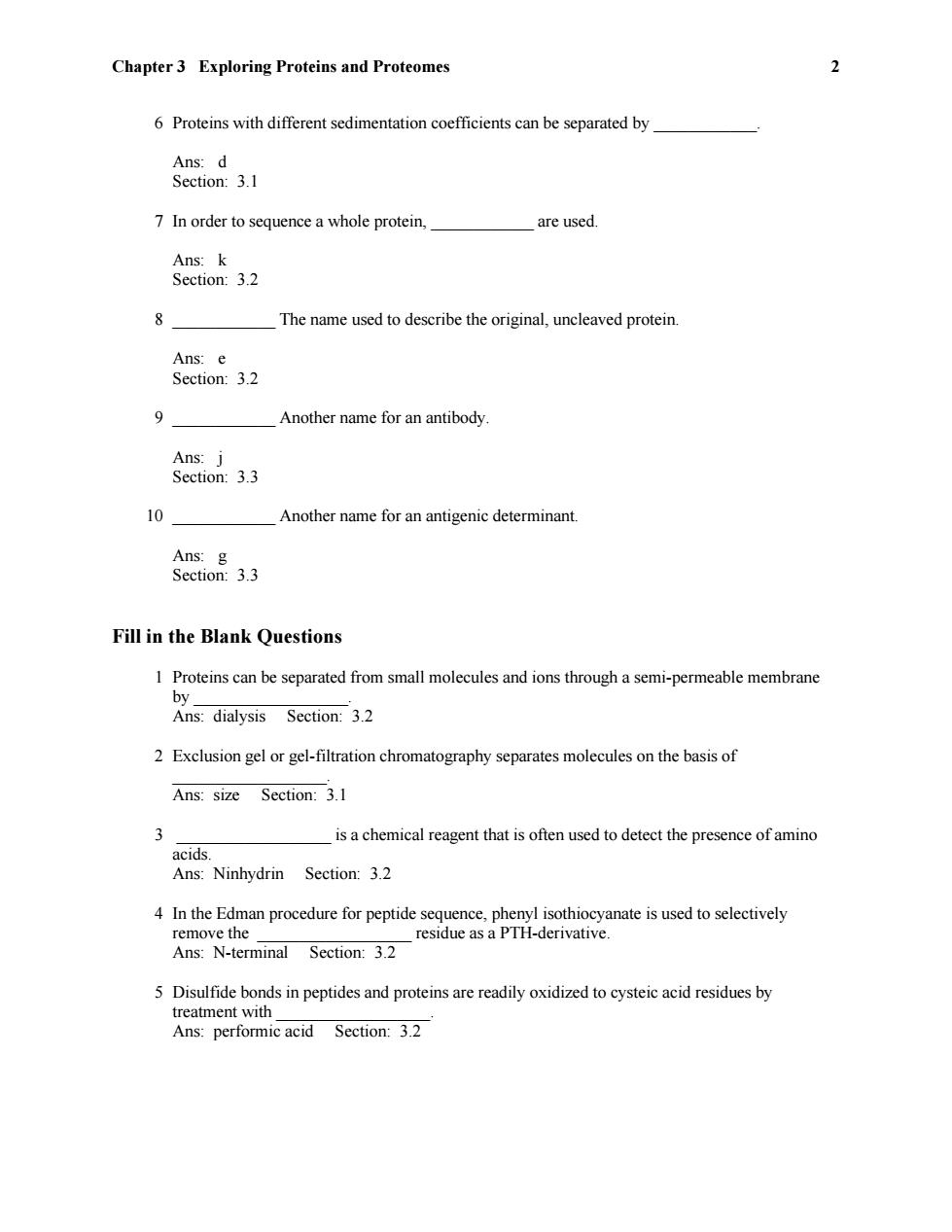
Chapter 3 Exploring Proteins and Proteomes 2 6 Proteins with different sedimentation coefficients can be separated by Ans:d Section:3.1 7 In order to sequence a whole protein, are used. Ans:k Section:3.2 P The name used to describe the original,uncleaved protein. Ans:e Section:3.2 9 Another name for an antibody Ans:j Section:3.3 10 Another name for an antigenic determinant Ans:g Section:3.3 Fill in the Blank Questions 1 Proteins can be separated from small molecules and ions through a semi-permeable membrane by Ans:dialysis Section:3.2 2 Exclusion gel or gel-filtration chromatography separates molecules on the basis of Ans:size Section:3.1 3 is a chemical reagent that is often used to detect the presence of amino acids. Ans:Ninhydrin Section:3.2 4 In the Edman procedure for peptide sequence,phenyl isothiocyanate is used to selectively remove the residue as a PTH-derivative. Ans:N-terminal Section:3.2 5 Disulfide bonds in peptides and proteins are readily oxidized to cysteic acid residues by treatment with Ans:performic acid Section:3.2
Chapter 3 Exploring Proteins and Proteomes 2 6 Proteins with different sedimentation coefficients can be separated by ____________. Ans: d Section: 3.1 7 In order to sequence a whole protein, ____________ are used. Ans: k Section: 3.2 8 ____________ The name used to describe the original, uncleaved protein. Ans: e Section: 3.2 9 ____________ Another name for an antibody. Ans: j Section: 3.3 10 ____________ Another name for an antigenic determinant. Ans: g Section: 3.3 Fill in the Blank Questions 1 Proteins can be separated from small molecules and ions through a semi-permeable membrane by __________________. Ans: dialysis Section: 3.2 2 Exclusion gel or gel-filtration chromatography separates molecules on the basis of __________________. Ans: size Section: 3.1 3 __________________ is a chemical reagent that is often used to detect the presence of amino acids. Ans: Ninhydrin Section: 3.2 4 In the Edman procedure for peptide sequence, phenyl isothiocyanate is used to selectively remove the __________________ residue as a PTH-derivative. Ans: N-terminal Section: 3.2 5 Disulfide bonds in peptides and proteins are readily oxidized to cysteic acid residues by treatment with __________________. Ans: performic acid Section: 3.2
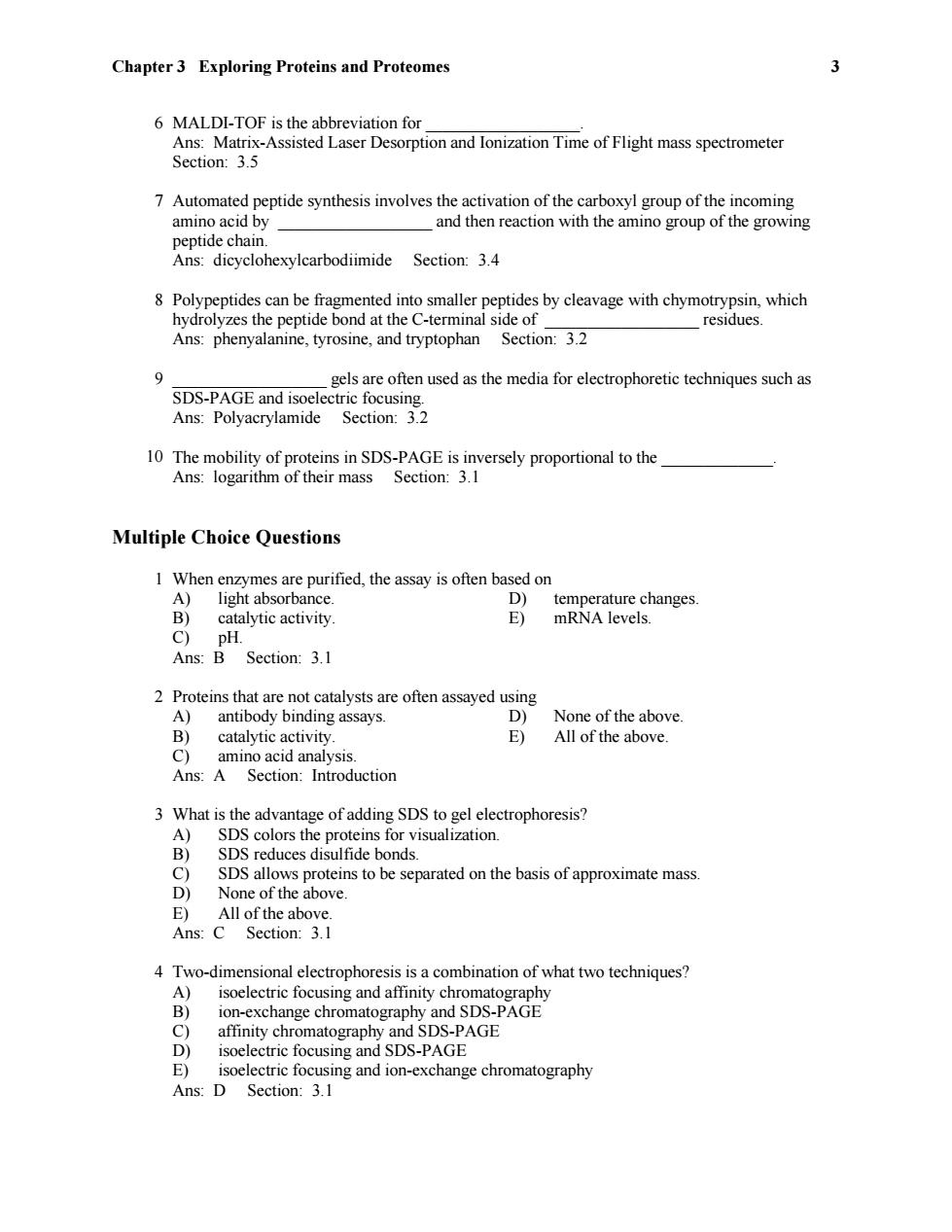
Chapter 3 Exploring Proteins and Proteomes 3 6 MALDI-TOF is the abbreviation for Ans:Matrix-Assisted Laser Desorption and Ionization Time of Flight mass spectrometer Section:3.5 7 Automated peptide synthesis involves the activation of the carboxyl group of the incoming amino acid by and then reaction with the amino group of the growing peptide chain. Ans:dicyclohexylcarbodiimide Section:3.4 8 Polypeptides can be fragmented into smaller peptides by cleavage with chymotrypsin,which hydrolyzes the peptide bond at the C-terminal side of residues Ans:phenyalanine,tyrosine,and tryptophan Section:3.2 9 gels are often used as the media for electrophoretic techniques such as SDS-PAGE and isoelectric focusing. Ans:Polyacrylamide Section:3.2 10 The mobility of proteins in SDS-PAGE is inversely proportional to the Ans:logarithm of their mass Section:3.1 Multiple Choice Questions 1 When enzymes are purified,the assay is often based on A) light absorbance. D) temperature changes. B) catalytic activity. E) mRNA levels. C) pH. Ans:B Section:3.1 2 Proteins that are not catalysts are often assayed using A) antibody binding assays. D) None of the above. B) catalytic activity. E) All of the above. C) amino acid analysis Ans:A Section:Introduction 3 What is the advantage of adding SDS to gel electrophoresis? A) SDS colors the proteins for visualization. B) SDS reduces disulfide bonds. C) SDS allows proteins to be separated on the basis of approximate mass. D) None of the above. E)All of the above. Ans:C Section:3.1 4 Two-dimensional electrophoresis is a combination of what two techniques? A)isoelectric focusing and affinity chromatography B) ion-exchange chromatography and SDS-PAGE C) affinity chromatography and SDS-PAGE D) isoelectric focusing and SDS-PAGE E) isoelectric focusing and ion-exchange chromatography Ans:D Section:3.1
Chapter 3 Exploring Proteins and Proteomes 3 6 MALDI-TOF is the abbreviation for __________________. Ans: Matrix-Assisted Laser Desorption and Ionization Time of Flight mass spectrometer Section: 3.5 7 Automated peptide synthesis involves the activation of the carboxyl group of the incoming amino acid by __________________ and then reaction with the amino group of the growing peptide chain. Ans: dicyclohexylcarbodiimide Section: 3.4 8 Polypeptides can be fragmented into smaller peptides by cleavage with chymotrypsin, which hydrolyzes the peptide bond at the C-terminal side of __________________ residues. Ans: phenyalanine, tyrosine, and tryptophan Section: 3.2 9 __________________ gels are often used as the media for electrophoretic techniques such as SDS-PAGE and isoelectric focusing. Ans: Polyacrylamide Section: 3.2 10 The mobility of proteins in SDS-PAGE is inversely proportional to the _____________. Ans: logarithm of their mass Section: 3.1 Multiple Choice Questions 1 When enzymes are purified, the assay is often based on A) light absorbance. D) temperature changes. B) catalytic activity. E) mRNA levels. C) pH. Ans: B Section: 3.1 2 Proteins that are not catalysts are often assayed using A) antibody binding assays. D) None of the above. B) catalytic activity. E) All of the above. C) amino acid analysis. Ans: A Section: Introduction 3 What is the advantage of adding SDS to gel electrophoresis? A) SDS colors the proteins for visualization. B) SDS reduces disulfide bonds. C) SDS allows proteins to be separated on the basis of approximate mass. D) None of the above. E) All of the above. Ans: C Section: 3.1 4 Two-dimensional electrophoresis is a combination of what two techniques? A) isoelectric focusing and affinity chromatography B) ion-exchange chromatography and SDS-PAGE C) affinity chromatography and SDS-PAGE D) isoelectric focusing and SDS-PAGE E) isoelectric focusing and ion-exchange chromatography Ans: D Section: 3.1
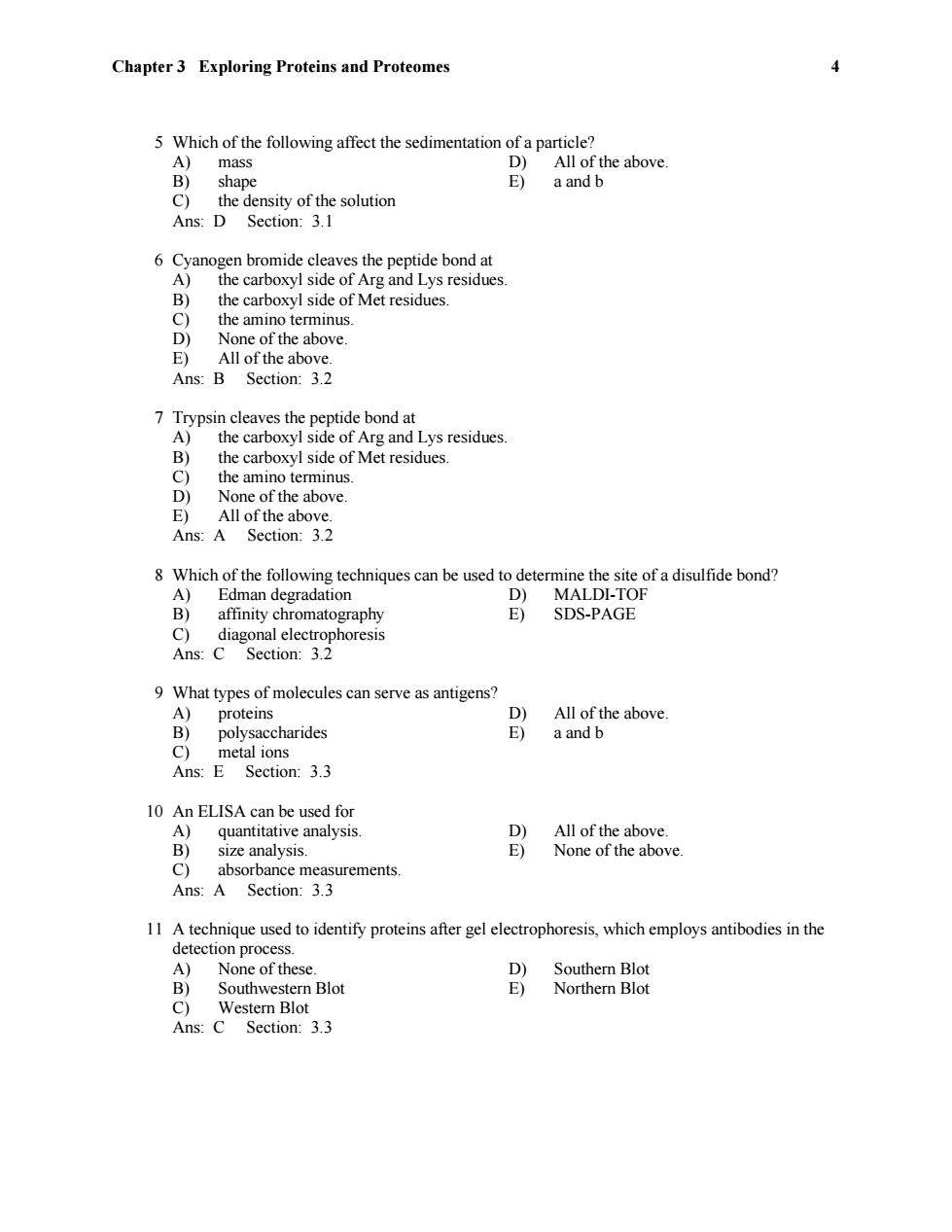
Chapter 3 Exploring Proteins and Proteomes 4 5 Which of the following affect the sedimentation of a particle? A)mass D) All of the above. B)shape E) a and b C)the density of the solution Ans:D Section:3.1 6 Cyanogen bromide cleaves the peptide bond at A)the carboxyl side of Arg and Lys residues. B) the carboxyl side of Met residues. C) the amino terminus D)None of the above E)All of the above. Ans:B Section:3.2 7 Trypsin cleaves the peptide bond at A)the carboxyl side of Arg and Lys residues. B) the carboxyl side of Met residues. C) the amino terminus. D) None of the above. E)All of the above. Ans:A Section:3.2 8 Which of the following techniques can be used to determine the site of a disulfide bond? A) Edman degradation D MALDI-TOF B) affinity chromatography E) SDS-PAGE C)diagonal electrophoresis Ans:C Section:3.2 9 What types of molecules can serve as antigens? A) proteins D) All of the above. B) polysaccharides E) a and b C) metal ions Ans:E Section:3.3 10 An ELISA can be used for A)quantitative analysis. D) All of the above. B) size analysis. E) None of the above. C) absorbance measurements Ans:A Section:3.3 11 A technique used to identify proteins after gel electrophoresis,which employs antibodies in the detection process. A) None of these. D) Southern Blot B) Southwestern Blot E) Northern Blot C)Western Blot Ans:C Section:3.3
Chapter 3 Exploring Proteins and Proteomes 4 5 Which of the following affect the sedimentation of a particle? A) mass D) All of the above. B) shape E) a and b C) the density of the solution Ans: D Section: 3.1 6 Cyanogen bromide cleaves the peptide bond at A) the carboxyl side of Arg and Lys residues. B) the carboxyl side of Met residues. C) the amino terminus. D) None of the above. E) All of the above. Ans: B Section: 3.2 7 Trypsin cleaves the peptide bond at A) the carboxyl side of Arg and Lys residues. B) the carboxyl side of Met residues. C) the amino terminus. D) None of the above. E) All of the above. Ans: A Section: 3.2 8 Which of the following techniques can be used to determine the site of a disulfide bond? A) Edman degradation D) MALDI-TOF B) affinity chromatography E) SDS-PAGE C) diagonal electrophoresis Ans: C Section: 3.2 9 What types of molecules can serve as antigens? A) proteins D) All of the above. B) polysaccharides E) a and b C) metal ions Ans: E Section: 3.3 10 An ELISA can be used for A) quantitative analysis. D) All of the above. B) size analysis. E) None of the above. C) absorbance measurements. Ans: A Section: 3.3 11 A technique used to identify proteins after gel electrophoresis, which employs antibodies in the detection process. A) None of these. D) Southern Blot B) Southwestern Blot E) Northern Blot C) Western Blot Ans: C Section: 3.3
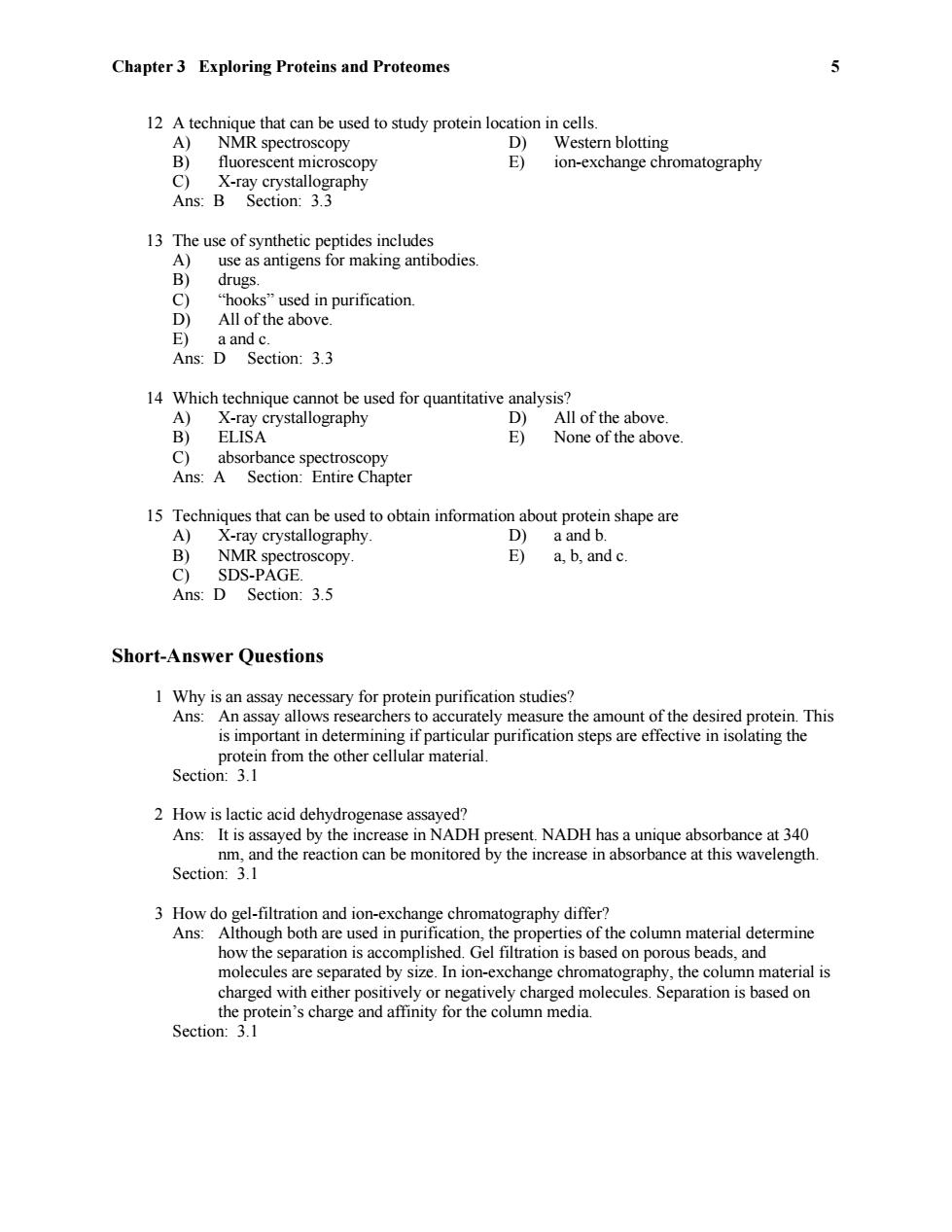
Chapter 3 Exploring Proteins and Proteomes 12 A technique that can be used to study protein location in cells. A) NMR spectroscopy D)Western blotting B) fluorescent microscopy E) ion-exchange chromatography C) X-ray crystallography Ans:B Section:3.3 13 The use of synthetic peptides includes A) use as antigens for making antibodies. B) drugs. C) "hooks"used in purification. D) All of the above. E)a and c. Ans:D Section:3.3 14 Which technique cannot be used for quantitative analysis? A)X-ray crystallography D)All of the above. B)ELISA E) None of the above. C) absorbance spectroscopy Ans:A Section:Entire Chapter 15 Techniques that can be used to obtain information about protein shape are A) X-ray crystallography. D)a and b. B) NMR spectroscopy. E) a.b,and c C)SDS-PAGE. Ans:D Section:3.5 Short-Answer Questions 1 Why is an assay necessary for protein purification studies? Ans:An assay allows researchers to accurately measure the amount of the desired protein.This is important in determining if particular purification steps are effective in isolating the protein from the other cellular material. Section:3.1 2 How is lactic acid dehydrogenase assayed? Ans:It is assayed by the increase in NADH present.NADH has a unique absorbance at 340 nm,and the reaction can be monitored by the increase in absorbance at this wavelength. Section:3.1 3 How do gel-filtration and ion-exchange chromatography differ? Ans:Although both are used in purification,the properties of the column material determine how the separation is accomplished.Gel filtration is based on porous beads,and molecules are separated by size.In ion-exchange chromatography,the column material is charged with either positively or negatively charged molecules.Separation is based on the protein's charge and affinity for the column media. Section:3.1
Chapter 3 Exploring Proteins and Proteomes 5 12 A technique that can be used to study protein location in cells. A) NMR spectroscopy D) Western blotting B) fluorescent microscopy E) ion-exchange chromatography C) X-ray crystallography Ans: B Section: 3.3 13 The use of synthetic peptides includes A) use as antigens for making antibodies. B) drugs. C) “hooks” used in purification. D) All of the above. E) a and c. Ans: D Section: 3.3 14 Which technique cannot be used for quantitative analysis? A) X-ray crystallography D) All of the above. B) ELISA E) None of the above. C) absorbance spectroscopy Ans: A Section: Entire Chapter 15 Techniques that can be used to obtain information about protein shape are A) X-ray crystallography. D) a and b. B) NMR spectroscopy. E) a, b, and c. C) SDS-PAGE. Ans: D Section: 3.5 Short-Answer Questions 1 Why is an assay necessary for protein purification studies? Ans: An assay allows researchers to accurately measure the amount of the desired protein. This is important in determining if particular purification steps are effective in isolating the protein from the other cellular material. Section: 3.1 2 How is lactic acid dehydrogenase assayed? Ans: It is assayed by the increase in NADH present. NADH has a unique absorbance at 340 nm, and the reaction can be monitored by the increase in absorbance at this wavelength. Section: 3.1 3 How do gel-filtration and ion-exchange chromatography differ? Ans: Although both are used in purification, the properties of the column material determine how the separation is accomplished. Gel filtration is based on porous beads, and molecules are separated by size. In ion-exchange chromatography, the column material is charged with either positively or negatively charged molecules. Separation is based on the protein’s charge and affinity for the column media. Section: 3.1